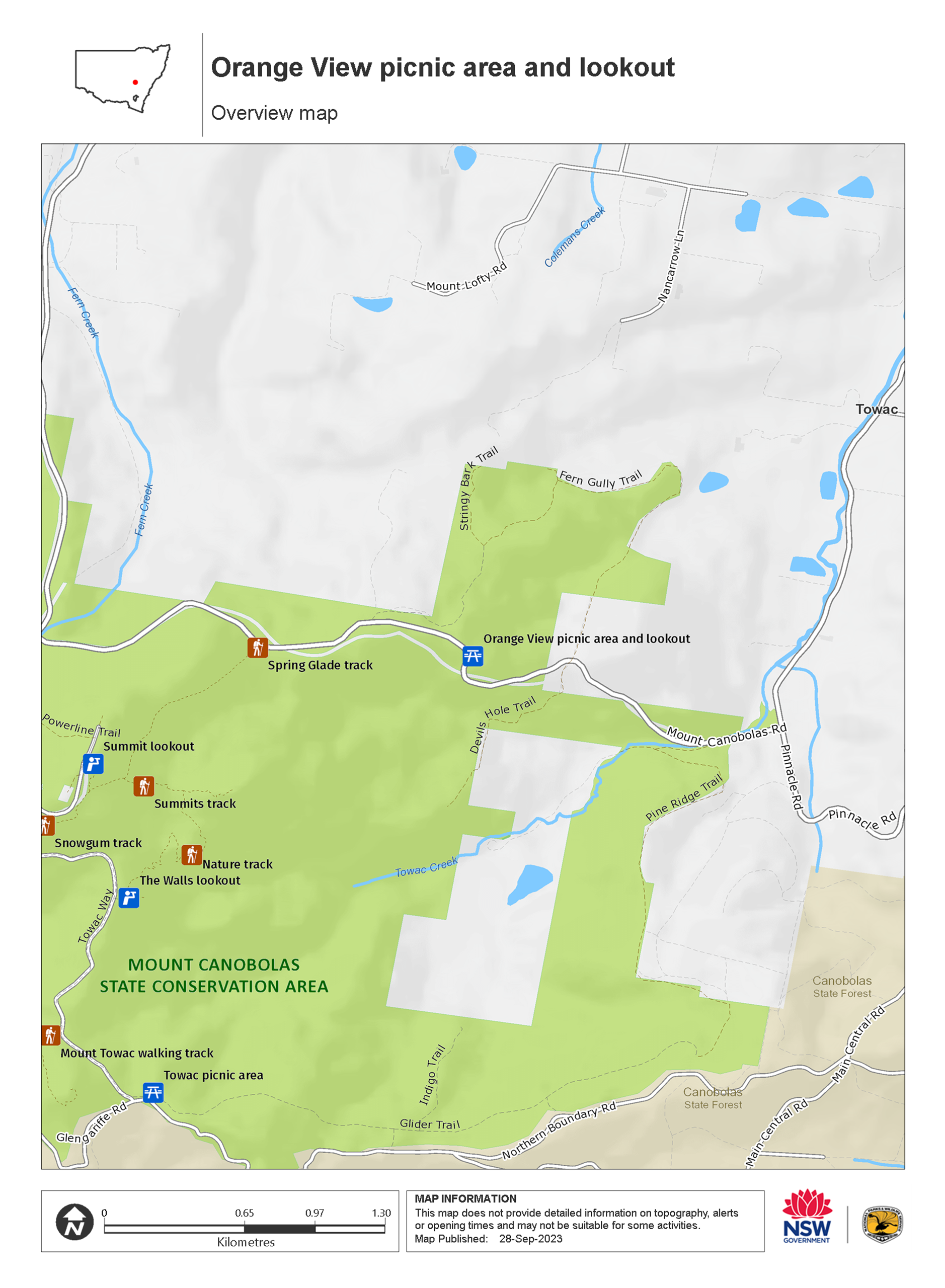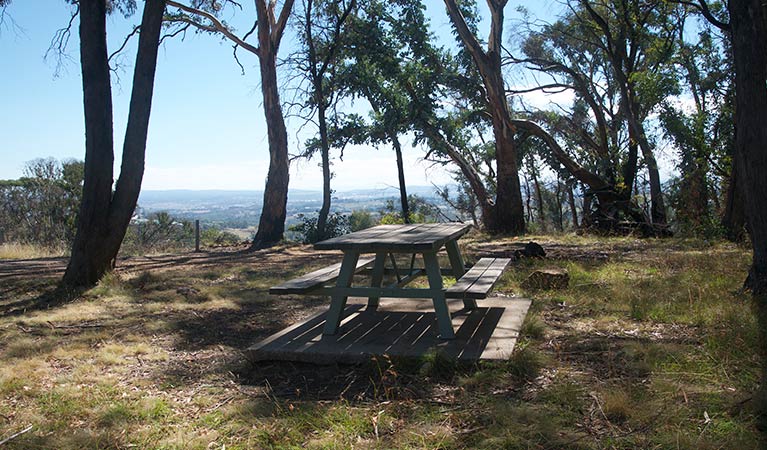Orange View picnic area and lookout
Mount Canobolas State Conservation Area
Open, check current alerts
Overview
Orange View picnic area and lookout offers views over the city of Orange and surrounding countryside. It’s also close to walking tracks in Mount Canobolas State Conservation Area.
- Type
- Picnic areas
- Accessibility
- Medium
- What to
bring - Drinking water, hat, sunscreen, snacks, suitable clothing
- Please note
- Wildflowers and other plants in this area are recovering from a severe 2018 bushfire.
A 20min drive from Orange, this small picnic spot part way up Mount Canobolas is a peaceful place to recharge with a snack and enjoy views before you set out on local walks.
Breathe in the fresh country air as you spread your lunch out on a picnic table beneath red stringybark and peppermint trees. Feast your eyes on the city of Orange below, and rolling hills stretching as far as your eye can see. From here you can also see the summit of Mount Canobolas, a dormant volcano.
The best time to come for wildflower displays is spring when the snowgrass understory bursts into life with blooms of violet kunzea, yam daisies, bacon and egg plants and ground orchids.
Bring your binoculars and keep an eye out for endangered flame robins with brilliant orange-red breasts, and crimson rosellas. If you come around dusk, you may hear the haunting call of the boobook owl or the chatter of sugar gliders.
From here there are plenty of opportunities to stretch your legs. The trailhead for Spring Glade walking track is just 1km up the road. Climb this track to the top of Mount Canobolas, then link up to Summits, Nature, Snowgum, and Federal Falls walking tracks.
Map

Map legend

Local alerts
For the latest updates on fires, closures and other alerts in this area, see https://www.nationalparks.nsw.gov.au/things-to-do/picnic-areas/orange-view-picnic-area-and-lookout/local-alerts
General enquiries
- National Parks Contact Centre
- 7am to 7pm daily
- 1300 072 757 (13000 PARKS) for the cost of a local call within Australia excluding mobiles
- parks.info@environment.nsw.gov.au
Park info
- in Mount Canobolas State Conservation Area in the Country NSW region
Mount Canobolas State Conservation Area is always open but may have to close at times due to poor weather or fire danger.
Visitor info
All the practical information you need to know about the Orange View picnic area and lookout.
Getting there and parking
Orange View picnic area and lookout is in Mount Canobolas State Conservation Area. To get there from Orange:
- Take Pinnacle Road or Lake Canobolas Road to Mount Canobolas Road.
- Continue on Mount Canobolas Road until you reach the picnic area, on your right.
Road quality
Take care on the narrow section of Mount Canobolas Road just before (below) the picnic area and lookout.
- Sealed roads
Vehicle access
- 2WD vehicles (no long vehicle access)
Weather restrictions
- All weather
Parking
Parking is available in a small, gravel carpark at the picnic area.
Facilities
Picnic tables
Carpark
Step-free access
There's step-free access around the picnic area and lookout, but there are no formal pathways. You'll need to cross over a mix of flat grass and hard-packed ground to get to the picnic table.
Maps and downloads
Accessibility
Disability access level - medium
Orange View picnic area and lookout is flat and step-free, but there are no pathways. You'll need to cross over flat grass and hard-packed ground to get from the carpark to the picnic table and lookout area.
There's a slight lip from the ground onto the concrete slab that the picnic table sits on.
Prohibited
Camping
Gathering firewood
Generators
Pets
Pets and domestic animals (other than certified assistance animals) are not permitted. Find out which regional parks allow dog walking and see the pets in parks policy for more information.
Smoking
NSW national parks are no smoking areas.
Learn more
Orange View picnic area and lookout is in Mount Canobolas State Conservation Area. Here are just some of the reasons why this park is special:
An Australian menagerie

Mount Canobolas has an abundance of native animals which thrive in this special environment. Around 950 species of plants and animals have been recorded in the park, including several species that exist nowhere else in the world. Thornbills, treecreepers, flame robins, wrens and honeyeaters, as well as good old magpies, currawongs, rosellas, kangaroos and wallabies call Mount Canobolas home. Threatened and endangered species like the antechinus marsupial mouse and silver-leaf candlebark can also be found in the area. When the sun goes down, grab your torch to spot the many possums and wombats, all the while being serenaded by the southern boobook owl.
- Snowgum walking track Snowgum walking track is short and easy, it starts from the summit of Mount Canobolas or from Federal Falls campground. It’s a great way to work up a hunger for a barbecue lunch.
- Spring Glade walking track Spring Glade walking track provides easy access to the summit of Mount Canobolas via a pleasant easy walk through grassy woodland, offering birdwatching and picnic opportunities.
Ancient connections

Mount Canobolas State Conservation Area incorporates the traditional land of the Wiradjuri People. The name Canobolas comes from the Wiradjuri words Gaahna Bulla meaning two shoulders, referring to the two main peaks, Old Man Canobolas and Young Man Canobolas. The area has a strong Aboriginal connection as an important place for male initiation ceremonies and stone tool making, as well as being a rich source of food and medicines. Find out more about this area's Aboriginal heritage at Federal Falls campground.
- Summit lookout Summit lookout in Mount Canobolas State Conservation Area is the highest peak in central-west NSW and offers stunning views. Just 18km from Orange and easy to get to, it’s ideal for a quick trip.
Outstanding landscapes

Now extinct and with a violent past, Mount Canobolas was an active and aggressive volcano responsible for creating the landscape between 11 and 13 million years ago. The result? Mount Canobolas State Conservation Area boasts vents, dykes, peaks and plugs which all can be seen here and the large rocky outcrops are home to rare lichens, towering basalt cliff lines and impressive waterfalls. The high altitude, cool climate and moist environment make this fertile ground for more than 300 plant species in the region. Large areas of snow gum subalpine woodland, grassy woodland and rocky outcrops covered with a variety of mosses and lichens make this a great place to visit. It’s hard to say what is most beautiful here, but certainly the heaths in spring which burst with purple, white, yellow and red flowers are a sight to behold.
- Mount Towac walking track This short walk will take you to Towac Peak where you can enjoy panoramic views of Mount Canobolas State Conservation Area and the scenic countryside of Orange.
Rising from the ashes

Mount Canobolas is recovering strongly from devastating fires that burned nearly 70% of the state conservation area in 2018. NPWS staff is working with the Orange Field Naturalist and Conservation Society to monitor, audit, and survey plant vegetation communities, insect and animal species, and Aboriginal sites. The park’s after-fire monitoring and conservation program has increased the number of known plant and animal species in the park, including discovery of 2 new ground orchid species new to science and rediscovery of 2 orchids unseen for over 20 years. As animals return, trees sprout new growth and plants come back there’s hope for the recovery of our native plants and animals.
Plants and animals protected in this park
Animals
-

Superb fairy wren (Malurus cyaneus)
The striking blue and black plumage of the adult male superb fairy wren makes for colourful bird watching across south-eastern Australia. The sociable superb fairy wrens, or blue wrens, are Australian birds living in groups consisting of a dominant male, mouse-brown female ‘jenny wrens’ and several tawny-brown juveniles.
-

Common ringtail possum (Pseudocheirus peregrinus)
Commonly found in forests, woodlands and leafy gardens across eastern NSW, the Australian ringtail possum is a tree-dwelling marsupial. With a powerful tail perfectly adapted to grasp objects, it forages in trees for eucalypt leaves, flowers and fruit.

